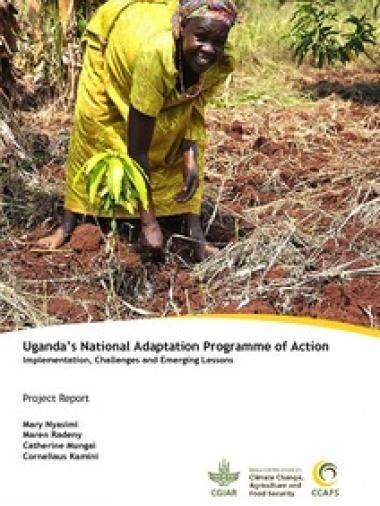Uganda’s National Adaptation Programme of Action: Implementation, Challenges and Emerging Lessons

The agrarian economy of Uganda has been declining due to many factors including climate change. With the majority of Ugandans depending on agriculture and agricultural related activities for their livelihoods, this decline is threatening their survival as well as Uganda’s future economic development. The changing climate is further compounding the problem of declining agricultural production, prompting the Government of Uganda (GoU) to take measures to address its the impacts. In 2007, Uganda submitted its National Adaptation Programme of Action (NAPA) to the United Nations Framework Convention on Climate Change (UNFCCC). The submission was made based on Uganda’s commitment to address climate change impacts as a signatory to the convention.
The NAPA aimed to prioritize and implement initiatives that respond to communities’ urgent needs to adapt to climate change. The NAPA identified nine adaptation priority areas. These included community tree growing; land degradation management; strengthening meteorological services; community water and sanitation; water for production; drought adaptation; vectors, pests and disease control; indigenous knowledge and natural resource management and climate change and development planning. This report assesses the status of the NAPA projects in Uganda, identifying the major activities for each of the projects, target beneficiaries and outcomes, including lessons learned and challenges arising from implementing the projects to inform policy. The report is based on a review of existing reports and other published literature from a variety of sources on NAPA in Uganda and interviews of personnel in various government departments, sub-county officials and beneficiaries.
Implementation of the NAPA was initiated in 2012 with funding from the Danish government for one-year (2011/12). The NAPA projects were piloted in four districts—Apac, Pallisa, Bundibugyo and Nakasongola—located in different ecosystems (arid, semi-arid, lowland and highlands). The initiative was led by the Ministry of Water and Environment (MWE), working with different agencies and local government to implement the activities at community level. Activities implemented within each of the projects focused on agriculture, energy and water. The target population for NAPA activities included men and women. Each district implemented on average 8-10 different adaptation actions, however, sustainability of the NAPA projects was not considered from the onset. The NAPA process did not establish a sustainability strategy as part of a comprehensive monitoring and evaluation plan. While the aim of the NAPA projects was to build community resilience, beneficiaries were not ready to adopt the new climate resilient technologies without more assistance from the project at the end of the implementation period, except for water storage tanks and the valley dam technologies.
The implementation period of one year was not sufficient to build long-term sustainability of the adaptation activities amongst communities, and the lessons learned have not been documented. Luckily the NAPA process created an opportunity for learning and identifying challenges that communities are facing in adapting to climate change, which were used to develop the National Adaptation Plan (NAP), Intended National Determined Contributions (INDC) and the Climate Smart Agriculture Program (2015-2025). Specifically, some of the activities implemented in NAPA are also outlined in the INDC, CSA program and NAP. Prominent inclusion of climate change adaptation actions have also been made on some of the polices and plans such as the National Development Plan, National Policy for Disaster Preparedness and Management, National Climate Change Policy.
At local level, issues of climate change adaptation are difficult to tackle, due to lack of knowledge on the effects and impacts of climate change and budgeting allocation for adaptation actions. As of 2015, despite adoption of the various policies and plans outlined above, Uganda’s national government is not allocating funds for local level adaptation. What are some of the emerging lessons from implementing NAPA pilot projects in Uganda? First, involving the community right from vulnerability assessment is essential for identification of adaptation strategies. Second, capacity building for community to manage and implement activities takes time and requires a lot of patience and commitment. Third, capacity building is necessary for local and national government staff to enable them to implement, monitor and evaluate projects with a gender lens. Lastly, community livelihoods are multifaceted and hence one activity is not sufficient to build adaptive capacity. Therefore, local governments need to promote multiple inventions that address climate change that build community resilience.
Citation
Nyasimi M, Radeny M, Mungai C, Kamini C. 2016. Uganda’s National Adaptation Programme of Action: Implementation, Challenges and Emerging Lessons. Copenhagen, Denmark: CGIAR Research Program on Climate Change, Agriculture and Food Security (CCAFS).